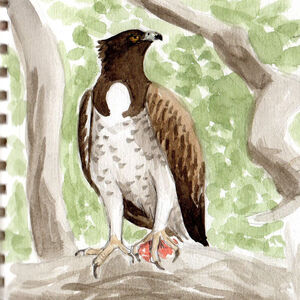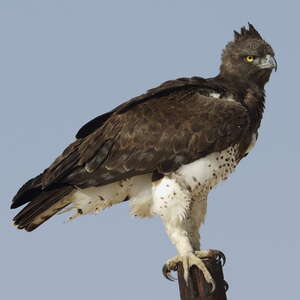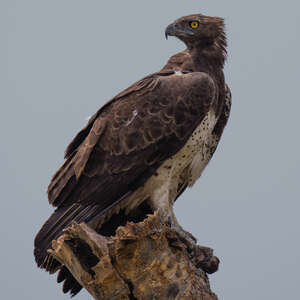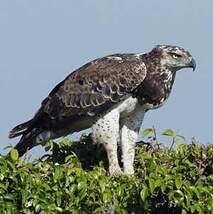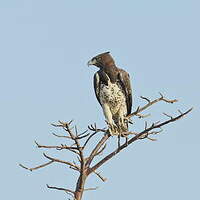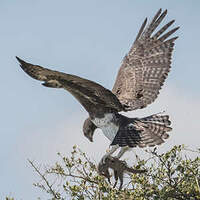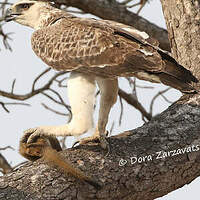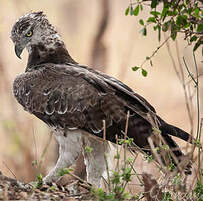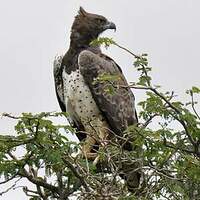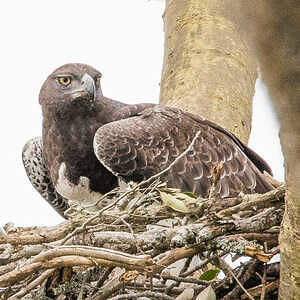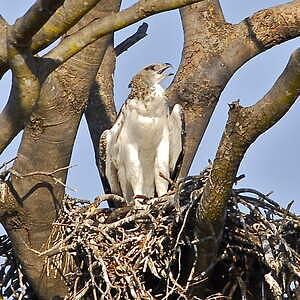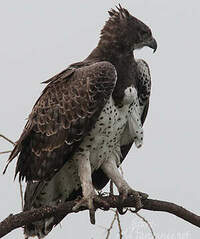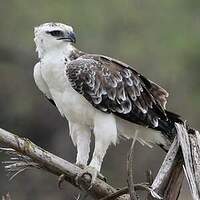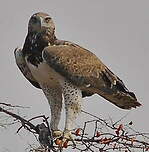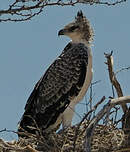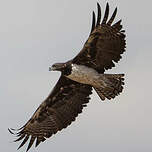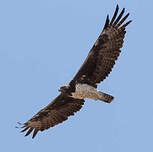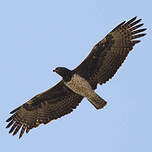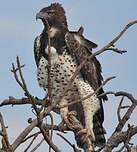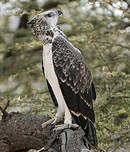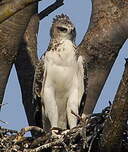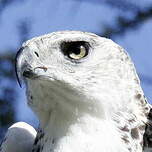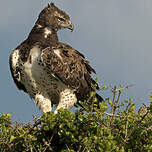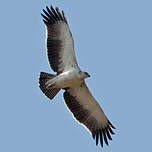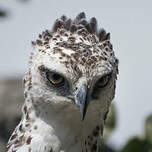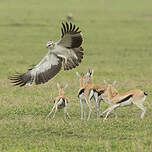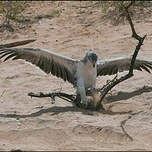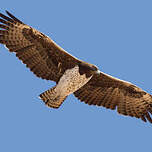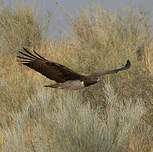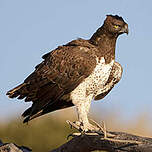Martial Eagle
Polemaetus bellicosus - Aigle martial
Identification
The Martial Eagle is, due to its size and the power it exudes, a truly impressive bird; it is the African eagle with the largest wingspan. The Verreaux's Eagle, and the Crowned Eagle are slightly bigger (96 cm and 90 cm in length, respectively), yet have a smaller wingspan (2m and 1.5-1.7m). Its military bearing as well as its powerful predatory skills make it one of the most intimidating birds of prey.
The thighs and breast are white, dotted with blackish brown, and the rest of the plumage is dark brown. The females, generally larger than the males, often have a denser abdominal punctuation. Apart from those two criteria, there isn't any marked sexual dimorphism.
The neck and the upper part of the breast are dark brown. The rear head, large and slightly flat, has a small crest. The eyes are yellow and piercing.
The tarsi, feathered, long and powerful, are topped by large yellowish talons with long, curved black nails.
The tail, rather short, on the lower side is white, striped in dark brown.
The wings are brown, with the remiges light and thinly striped in black.
The black beak is strongly hooked, with a yellowish base.
For adults, identification confusion can possibly arise with the Black-chested Buzzard-Eagle, Circaetus pectoralis, even though the latter is smaller with a breast devoid of dots.
The young differ significantly from the adults. They are much lighter, the ventral parts are not dotted, their head is white, with some brown feathers scattered; the iris is brown.
When flying, confusion can possibly occur with the juvenile from the Crowned Eagle, Stephanoaetus coronatus. The wings of the immature Martial Eagle, however, are larger, whiter, with lesser striped wings.
Subspecific information monotypic species
Foreign names
- Aigle martial,
- Águila marcial,
- águia-marcial,
- Kampfadler,
- vitézsas,
- Vechtarend,
- Aquila marziale,
- stridsörn,
- Kampørn,
- orol bojovný,
- orel bojovný,
- Kampørn,
- gasellikotka,
- Breëkoparend,
- àguila marcial,
- wojownik zbrojny,
- Боевой орёл,
- ゴマバラワシ,
- 猛雕,
- 猛鵰,
Voice song and cries
The Martial Eagle is usually silent. However, during the breeding season, a loud display song, kwi-kwi-kluee-kluee, is sung in flight or while perched atop a tree. The main contact call between members of a pair, often when perched, is a soft whistling ko-wee-oh sound. It is also used by the female when the male brings food or by the young ones when begging for their meals.
Habitat
This raptor can be found at all altitudes up to 3,000 meters but is more frequently spotted below 1,500 meters. Its favorite habitats are savanna, steppe, semi-deserts, and areas dotted with thorny bushes. It's not common in dense forests but does sometimes nest in the fringes of such. In the absence of trees to build a nest, it can use electricity poles in desert areas (Karoo, South Africa).
Behaviour character trait
Often at high altitude, the Martial Eagle spends more time flying than other African eagles. It excels in exploiting thermals, but its morphology does not make it very agile in maneuvers; this may be the reason why it avoids dense forests.
This raptor can cover large distances but is not a migratory bird. Hunting mostly in flight, it can sometimes perch at the top of a lookout. The speed and power of its attacks make it a formidable predator. See: Video It lives alone or in pairs and keeps away from humans.Dietfeeding habits
The diet of the Martial Eagle varies depending on the availability in its territory. It eats a variety of medium sized mammals, birds, and lizards that generally weigh between 1 and 5 kilograms.
Prey can sometimes be much heavier; for example it has been observed to predate on an antelope (Cephalophus natalensis) of more than 35 kg.As a carnivore, it mostly hunts mammals such as: Damans, ground squirrels, mongooses, small antelopes (Thomson's Gazelles, Impala calves, duikers), jackals, servals...
A study in the Cape Province (South Africa) showed that Cape hares were the dominant prey (50%), followed by common Zorrills, Genets, ground squirrels and mongooses.
In lesser amounts, it also hunts Vervet Monkeys and Baboons.
In some cases, birds constitute an important part of the menu, it then attacks Guinea Fowl, francolins and bustards. Predation on a large bird such as the White Stork has been photographed (Masai Mara, Kenya). See: Photos
It will not disdain Varans and occasionally snakes.
Reproduction nesting
The Martial Eagle is monogamous. Apart from a particular call (see above), there is no real courtship display. However, when a couple circle over the breeding area, the female may be led to turn around and present her claws to the male.
The breeding period takes place during the dry season of each region.
The Martial Eagle reproduces most frequently once every two years rather than once a year.
Nests are built on dominant trees (most frequently 6 to 20 meters high), often placed on hills/mounds, allowing them to have a clear view.
A couple will nest in the same area for several years.
The nest is imposing: 1.20 to 1.50 meters in diameter and 60 centimeters deep; over the different seasons it can reach a size (diameter and depth) of about 2 meters. Made of branches, it is lined with green leaves.
The female lays an egg (sometimes two). The incubation period, mostly undertaken by the female, lasts for about 45-50 days (only at night after the 20th day). The male doesn't feed her, so she is obliged to leave the nest in search of food.
Weak at hatching, the chick, active after the 20th day, starts to pluck feathers by the end of the first month, this phase not being completed until around the 90-100th day. Both parents give it the beak for two months, then the fledgling is able to tear the prey alone. See: Video
At the same time, the presence of the male is less and less regular.
The young one takes off around the 100th day.His attachment to the nest is becoming less and less pronounced, yet the first six months he doesn't stray far. He's fully independent at 2-3 years old and reaches sexual maturity at 4-5 years old. (Allan, 1996; Burton Burton, 2002; Machange, Jenkins, Navarro, 2005; Simmons Brown, 2006; Thiollay, 1994)
The territory of a Martial Eagle couple is 125 to 140 km2 in Eastern and Southern Africa, with proximity between nests of 10 to 11 km; it extends from 250 to 990 km2 in Zimbabwe (Hange National Park) with proximity of 35 km.
Geographic range
The Martial Eagle can be found in most countries of Sub-Saharan Africa, from Senegal to the northwest of Somalia and in Southern Africa. It avoids dense forests and is absent from most of Central Africa. It is present throughout its geographical range (with a status ranging from uncommon to rare). Population densities are higher in major protected areas (such as South Africa and Zimbabwe). It is believed to have suffered a significant decline over much of its range (including in Namibia and Nigeria).
Threats - protection
IUCN conservation status
concern
in the Wild
threatened
evaluated
On the African continent, many raptors are undergoing a significant decline. Iconic species such as the Bateleur (Terathopius ecaudatus) and the Martial Eagle have been classified as Near Threatened by the IUCN.
The Martial Eagle has seen a significant decrease in its numbers over the past three generations (56 years). The classification of Vulnerable could be considered.
This is certainly the most persecuted raptor in southern Africa; the species is subject to direct persecution by farmers, and shooting and poisoning are the most important causes of losses. Poisoning is widely practiced (in Namibia and South Africa) by livestock owners who suffer losses in their poultry, lambs and goats (an overestimation is possible). The reduction of natural prey could be at the origin of this change in behavior. Drowning in reservoirs, electrocution, habitat alteration and modifications are also contributing to its decline.
In Namibia, the Martial Eagle is endangered. Only about 350 pairs remain in the country (estimated to be a decrease of 80% of the population in the past five years).
Deforestation might have a lesser impact on this species than on other African large eagles, since they can nest on artificial structures (electric pylons, for example).
In some regions, the birds are used for traditional medicine.
Local initiatives are being implemented in South Africa. For example, a system of compensation for livestock losses has been set up for livestock owners.
Awareness campaigns on the consequences of biodiversity loss, as well as the installation of anti-electrocution systems on electric pylons, could be beneficial measures for the future of this iconic bird.
Sources of information
- IOC World Bird List (v14.1), Gill, F and D Donsker (Eds). 2024-04-18.
- BirdLife International, BirdLife International
- Encyclopedia of life,
- Animal Diversity Web, University of Michigan Museum of Zoology
- Raptors of the World, a field guide, Ferguson-Lees James et Christie David
- Birds of Africa South of the Sahara, Ian Sinclair and Peter Ryan
- Vol. 2 - Handbook of the Birds of the World, Josep del Hoyo-Andrew Elliot--Jordi Sargatal
- The kiler birds of Kruger, Brett Hilton-Barber Lou Arthur
- ARKive, Christopher Parsons
- wildlife Extra,
Other sources of interest
 Specification sheet created on
29/07/2023 by Yvonnik Lhomer
Specification sheet created on
29/07/2023 by Yvonnik LhomerTranslation by AI Oiseaux.net
published: 26-12-2010 - Updated: 06-10-2013
© 1996-2024 Oiseaux.net
- Accipitriformes
- Aegotheliformes
- Anseriformes
- Apodiformes
- Apterygiformes
- Bucerotiformes
- Caprimulgiformes
- Cariamiformes
- Casuariiformes
- Charadriiformes
- Ciconiiformes
- Coliiformes
- Columbiformes
- Coraciiformes
- Cuculiformes
- Eurypygiformes
- Falconiformes
- Galliformes
- Gaviiformes
- Gruiformes
- Leptosomiformes
- Mesitornithiformes
- Musophagiformes
- Nyctibiiformes
- Opisthocomiformes
- Otidiformes
- Passeriformes
- Pelecaniformes
- Phaethontiformes
- Phoenicopteriformes
- Piciformes
- Podargiformes
- Podicipediformes
- Procellariiformes
- Psittaciformes
- Pterocliformes
- Rheiformes
- Sphenisciformes
- Steatornithiformes
- Strigiformes
- Struthioniformes
- Suliformes
- Tinamiformes
- Trogoniformes

